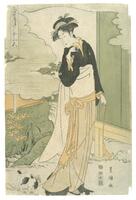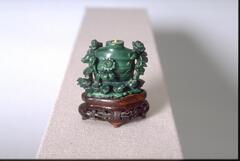449 UMMA Objects
449 UMMA Objects

Yokoi Kinkoku (Japanese (culture or style))
Portrait of the Poet 'Basho'
1767 – 1832
Museum purchase made possible by the Margaret Watson Parker Art Collection Fund
1968/2.22

Chinese (Chinese (culture or style))
Ivory Snuff Bottle
1912 – 1949
Gift of Mr. Robert W. Coggan
1980/2.71

Utagawa Toyokuni I (Japanese (culture or style))
A Modern Sannomiya: Maid and Cat
1767 – 1832
Museum Purchase
1960/1.164

Chinese (Chinese (culture or style))
Imperial Jacket
1867 – 1899
Gift of Willard A. & Marybelle Bouchard Hanna
1991/2.38

Kuba (Kuba (Democratic Republic of Congo style))
Double Neckrest
1867 – 1899
Museum Purchase
1985/2.52
![It has a small straight rim. Abstract flowers is decorated on the shoulder in the cobalt blue. The body shapes octagonal form.<br />
<br />
This white porcelain jar has an octagonal body and is decorated with vignettes in underglaze cobalt blue on the upper part of the shoulder. Its recessed base, created by removing clay from the bottom, retains traces of fine sand support. This angular bottle was shaped using a mold and has a strong sheen. A large number of cracks and contaminants, however, have darkened the surface. The clay is well sintered, forming a sturdy body.<br />
[Korean Collection, University of Michigan Museum of Art (2014) p.175] It has a small straight rim. Abstract flowers is decorated on the shoulder in the cobalt blue. The body shapes octagonal form.<br />
<br />
This white porcelain jar has an octagonal body and is decorated with vignettes in underglaze cobalt blue on the upper part of the shoulder. Its recessed base, created by removing clay from the bottom, retains traces of fine sand support. This angular bottle was shaped using a mold and has a strong sheen. A large number of cracks and contaminants, however, have darkened the surface. The clay is well sintered, forming a sturdy body.<br />
[Korean Collection, University of Michigan Museum of Art (2014) p.175]](/media/W1siZiIsIjIwMjIvMDUvMjUvNWRldWpibGR1MF9kZWZhdWx0LmpwZyJdLFsicCIsInRodW1iIiwiMjQweDIwMCJdXQ?sha=1263f52c62ec2d4b)
Korean (Korean (culture or style))
Small faceted bottle
1850 – 1899
Gift of Mrs. Caroline I. Plumer for the James Marshall Plumer Collection
1977/1.196

Korean (Korean (culture or style))
Blue-and-white octagonal water dropper with floral design
1850 – 1899
Gift of Mrs. Caroline I. Plumer for the James Marshall Plumer Collection
1977/1.197

Chinese (Chinese (culture or style))
Malachite ornamental snuff bottle
1912 – 1949
Gift of Mr. Robert W. Coggan
1980/2.42

Chinese (Chinese (culture or style))
Round Embroidery
1867 – 1932
Gift of Mr. and Mrs. Herbert W. Johe
1989/2.77

Henri de Toulouse-Lautrec
Madame Rejane
1867 – 1899
Gift in honor of Louis C. and Helen Grace Andrews
2014/1.622
Loading…


